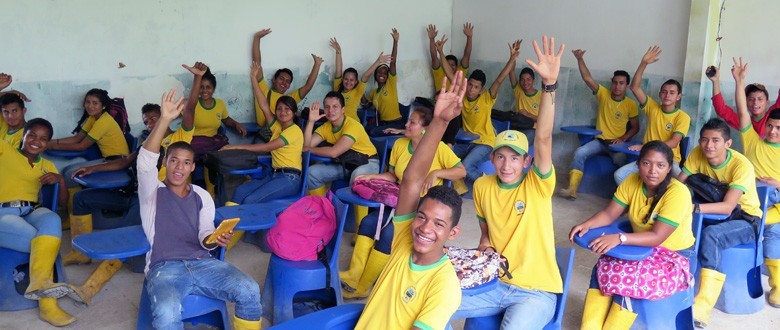
Violence often spikes during the chaos, strain and instability that follow natural disasters. The destruction of livelihoods, and loss of protection and security provided by the community and family place many adolescents at risk. They tend to show post-earthquake fears, impaired identity formation, a foreshortened and pessimistic sense of future, antisocial behaviours such as vandalism and truancy, depression, anxiety, belligerence, school-related problems and interpersonal difficulties. In the aftermath of natural disasters, schools, unfortunately, are not necessarily the safe havens we would hope them to be for young people trying to find their bearings.
A recent VVOB survey in the Province of Santo Domingo de los Tsáchilas, one of the provinces that was most affected by the deadly earthquake that shook Ecuador last April, revealed that more than 90 per cent of school counsellors consider violence in schools a serious to very serious problem. To build school counsellors’ capacity to address the matter, VVOB initiated a collaboration with the Lima-based Latin American affiliate of the International Institute of Restorative Practices.
A deep-seated problem
Already in 2011, a study of the Economic Commission for Latin America and the Caribbean (ECLAC) brought to light that three out of five Ecuadorian students fall victim to some type of violence at the hands of their classmates (theft, insults, beatings or threats). The figures corroborate the saying that a school is not an island, with classroom violence reflecting the level of violence in the surrounding society. At the time, official sources placed violence as the second cause of mortality amongst young people in Ecuador.
Results from the 2013 Third Regional Comparative and Explanatory Study (TERCE), a large-scale study of learning achievement conducted with grade 6 students in 15 countries in Latin America, confirm that the problem is persistent. The study showed that high percentages of Ecuadorian boys and girls are still victims of physical and psychological forms of bullying. Moreover, the perception of violence in the environment around schools has a very negative impact on learning in Ecuador, more so than in any of the other countries that participated in the study.
Restoring the school community
As part of its response to the April earthquake, VVOB has partnered with the Lima-based Latin American affiliate of the International Institute of Restorative Practices (IIRP). Restorative practices are a methodology that evolved from restorative justice. The aim of the approach is to build healthy communities, reduce the impact of situations that cause stress in the community such as natural disasters or crime, decrease antisocial behavior, repair harm and restore relationships. Educators have come to recognize the importance of restorative practices for fostering healthy, safe and supportive school climates.
Rather than simply punishing offenders, restorative justice holds offenders accountable for their crimes by involving them in face-to-face encounters with the people they have harmed. Research in restorative justice has revealed very positive outcomes for victims and offenders alike, including reduction in reoffending. Similar restorative practices in schools have yielded significant improvements in behavior and school climate as well.
Introducing restorative practices in Ecuador
To introduce the concept and practices of restorative practices in Santo Domingo de los Tsáchilas’ secondary technical schools, VVOB and IIRP set up a capacity building trajectory for staff from the Ministry of Education, school leaders and school counsellors. Through a series of workshops, provided by experienced psychological advisors from the Peruvian Ministry of Education and trained VVOB staff, school counsellors and school leaders got a practical initiation in some fundamental techniques, such as restorative circles. The training treated topics such as harassment and bullying in schools, drugs sale and consumption, but also topics that most Ecuadorian educators find much more sensitive, such as sexual harassment and gender-based violence. Given the sense of urgency created by the April earthquake, the focus was on practical application. A few months after the trainings, the vast majority of the 105 school counsellors who participated have now implemented restorative circles with groups of students, teachers and families. During this period, they could count on VVOB staff for follow up and coaching.
The first results are promising, as Santo Domingo’s school counsellors and school leaders’ of the Province’s secondary technical schools respond positively to the new approach. In a next phase, VVOB’s support will increasingly shift to ensuring institutionalisation.




